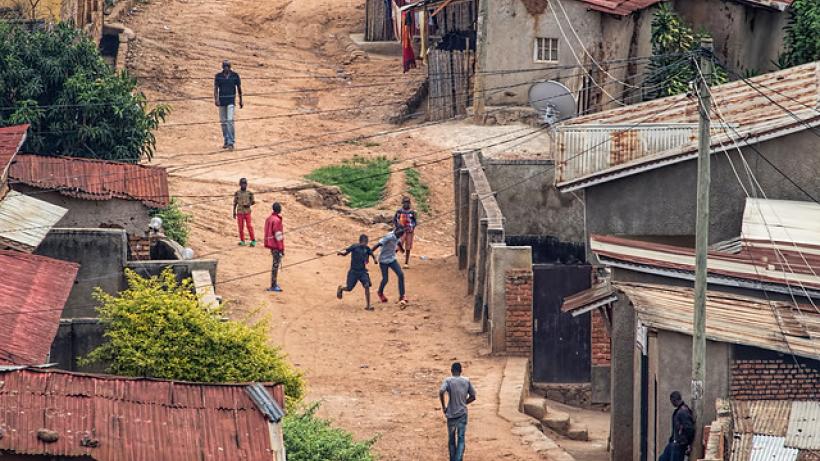
What do surveys and SMS data reveal about Kigali’s unplanned settlements?
Households living in unplanned areas of Kigali make complex trade-offs in terms of where they work and live. We use face-to-face and SMS surveys to understand these trade-offs as well as general patterns in migration, employment, mobility, housing, and access to infrastructure and services. Building an understanding of these dynamics is key for urban upgrading and more inclusive urban planning.
The City of Kigali is Rwanda’s main urban centre. At present, the city accommodates about half the urban population while accounting for 40% of total GDP and 61% of total non-agricultural GDP[1] (World Bank 2017). Rapid urban growth in Kigali has led to the development of “unplanned settlements,”[2] with official estimates putting the population living in Kigali’s unplanned settlements at 79% of the city’s total population.
Laterite, with support and funding from the International Growth Centre (IGC) and in close collaboration with the City of Kigali, worked on a first-of-its-kind multidimensional field survey of 1,594 households in unplanned settlements in Kigali using a combination of face-to-face and SMS surveys. The study took place over the course of three months and involved the use of satellite imagery analysis[3] to identify unplanned areas across the city.
Kigali is a city of migrants
We estimate that about 65% of current adult residents in unplanned settlements – aged 18 or above – in 2018 were born outside of the Kigali Province, but in Rwanda. The proportion of migrants is higher in unplanned areas of the city, than in “planned areas”.
Migrants are more likely to be tenants and live in smaller housing. They are more mobile and change housing more often than individuals/households born in Kigali. Their housing situation in Kigali stabilises and becomes more permanent over time.
Recent migrants - arriving over the past five years – account for about 15% of the population of unplanned settlements. An estimated 63% of recent migrants identified seeking business opportunities or paid employment as one of the main reasons they moved to Kigali.
Unemployment and underemployment for household heads are highly correlated with their age, gender, education, and migration status
Unemployment in unplanned areas was approximately 18%. Aggregate unemployment estimates remained stable in subsequent SMS follow-up surveys. At the individual level, however, there is a lot of movement in and out of the job-market. About one-quarter of heads-of-household transited in or out of jobs during the three-month period between the face-to-face survey and the SMS follow-up surveys.
Underemployment affects one in three working heads-of-household (36%) in unplanned settlements (these are household-heads that worked less than 35 hours per week).
Residents in Kigali are geographically constrained – they tend to work close to where they live
Over 70% of household heads live within two kilometres from their work place (straight-line distance) with an estimated 44% of employed heads-of-household working in the sector in which they live; the remaining workers transit to nearby areas. Travel on foot is the most common mode of transport. Over half of working heads-of-household in Kigali’s unplanned settlements commute by foot.
The cost of public transport is a binding constraint for low-income households. Commute time for unplanned residents is also hampered by poor infrastructure. Bus waiting times are especially problematic in areas that are located farther away from the city core, while access to main roads is a problem for isolated settlements
Households in unplanned areas fairly evenly split between tenants and owner-occupants
Tenants are more likely to face the burden of poor quality, unaffordable accommodation, and rental insecurity. Tenants are more likely to live in smaller dwelling units and with a median level of 27,000 Rwandan Francs per month, rent affordability in unplanned areas is a concern for low-income households. Access to housing finance appears to be a major constraint for homeowners or prospective homeowners. Savings (not credit) is the most common sources of finance.
The quality of housing in unplanned areas is variable, with low-quality walling materials but high-quality roofs and floors. Compound living is the most common form of housing arrangement in unplanned settlements, with an estimated 68% of households living in enclosed areas. Housing supply trends indicate a gradual outward expansion (sprawl) of Kigali, although these trends might have stalled in recent times.
Access to basic services is high – but with some caveats
We estimate that 87% of households in unplanned settlements have access to improved water sources, but only 56% reported access to a piped water connection either in their house or in their compound. Similarly, access to improved sanitation is near universal, but most households – nearly 65% - use pit latrines as a means of waste disposal. Kigali currently lacks a centralised sewerge system.
Policy implications
- The importance of the housing-transport trade-off that most households make. Residents in unplanned settlements face major costs when it comes to travelling further away from their households for work. This has implications for land use planning and transportation improvements.
- Potential issues related to affordability resulting from urban upgrading. Rents are higher for residents with access to services and better infrastructure, highlighting that large-scale upgrading efforts need to take into account consequences for tenants. Gradual community level upgrading efforts might be a way to ensure a more inclusive urban development.
- The importance of skill development and education on income. Residents living in unplanned settlements are likely to benefit from city-wide initiatives to develop human capital.
References
World Bank (2017), Rwanda economic update.
Bachofer, F and S Murray (2018), “Remote sensing for measuring housing supply in Kigali”, IGC project, https://www.theigc.org/project/remote-sensing-measuring-housing-supply-kigali/
Footnotes
[1] World Bank (2017), Rwanda economic update.
[2] The term “unplanned” is used to refer to informal settlements in Kigali because, unlike many informal areas across the world, the majority of households in Kigali’s unplanned areas have legal tenure and title.
[3] Bachofer, F and S Murray (2018), “Remote sensing for measuring housing supply in Kigali”, IGC project, https://www.theigc.org/project/remote-sensing-measuring-housing-supply-kigali/

